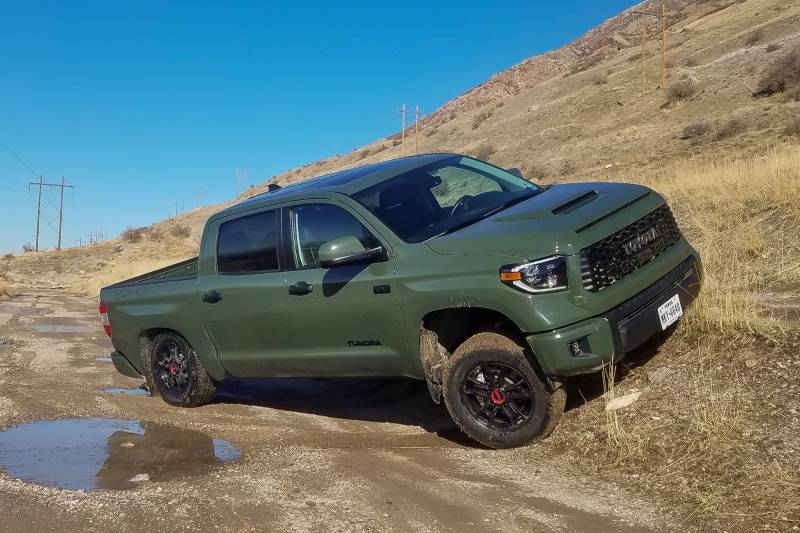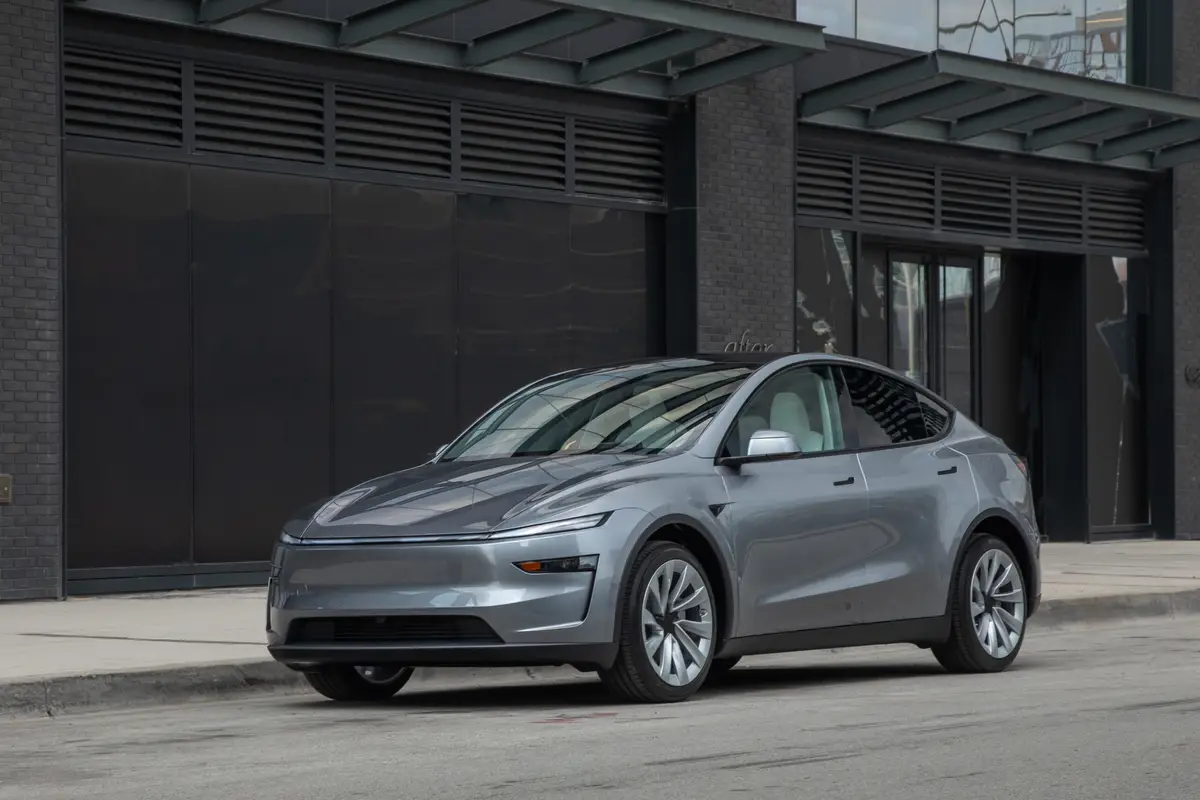Working and Playing With the 2020 Toyota Tundra TRD Pro
Cars.com photos by Matt Barnes
Toyota has never been a top player in the full-size pickup truck market, but the Tundra has always sold well and is noted for its . For 2020, the second-generation Tundra carries on with the same powertrain from when it was introduced in 2007, yet it's still relevant today. I recently tested the slightly updated 2020 Tundra TRD Pro (the most off-road-capable Tundra) while towing and off-road to see if it's the ultimate work and outdoors truck.
Off-Roading With the Tundra TRD Pro
To start my week off with the Tundra, I took a trip to the Little Sahara Recreation Area in Utah for some play. This involved roughly 80 miles of highway driving one way, giving me a good idea of the Tundra's high-speed pavement manners. The 5.7-liter V-8 with 381 horsepower and 401 pounds-feet of torque and six-speed automatic transmission had plenty of power to get up to speed, merge onto the freeway and pass slower-moving vehicles out on the country roads. My specific TRD Pro model came with a payload capacity of 1,235 pounds, which is on the lower end for this size of truck. Having the lower payload allows Toyota to tune the Tundra for a smooth on-road ride, and the truck always felt stable and linear on the highway.
Related:
Once in the sand, I was impressed by how well the Tundra was able to grip given the near highway tread of the 32-inch-tall Michelin LTX A/T2 tires. As far as all-terrain tires go, the Michelin LTX A/T2s are some of the least aggressive tires on the market. Much of the reason the tires did so well was that traction on the sand was high. Temperatures were in the low 40s and the sand was wet with snow on the north-facing slopes. Power from the V-8 made climbing the dunes an easy task. The TRD-tuned Fox 2.5-inch front and rear shocks handled the undulations in the sand without any noticeable heat or fade. The extra ride height of the TRD Pro was beneficial in many situations with better approach, departure and breakover angles than the rest of the Tundra lineup. Maybe I didn't play hard enough, but the Tundra never got stuck in a place that it couldn't drive out of under its own power.
In 2WD, I found that the traction and stability control systems can't be fully disabled — but if I disabled them in 4WD, then switched into 2WD, the systems stayed off. This workaround allowed for some 2WD sand drifting. Some people prefer high-speed off-road driving in 2WD because it's easier to bring the rear end around in the corners.
Towing With the Tundra TRD Pro
New for 2020, all Tundras come with a and a factory-installed trailer brake controller. This is a great idea that all manufacturers should implement in all full-size trucks and SUVs. To test this, I towed a trailer weighing in at just under 6,000 pounds with a 1,000-pound tongue weight. Typically, it's best to keep the tongue weight as close to 10% of the trailer weight as possible, but this setup gives a good idea of how much the truck will squat when loaded to its max. Toyota recommends using a weight distribution hitch for any trailer over 5,000 pounds or tongue weight over 500 pounds, but I was unable to secure one for the few hours that I had the trailer. Without the weight distribution hitch, the heavy tongue weight caused the Tundra to sag significantly in the rear. Even with the sag, I never felt the suspension bottom out, and the load was always controlled and stable, with no steering issues. I had no problem getting up to speed or stopping the trailer in a reasonable distance.
As a work truck, I found that the short 5.5-foot bed on the CrewMax is almost too small. If a longer bed is needed, the 2020 Tundra TRD Pro trim is also available once again as a double cab with the 6.5-foot bed. There were still plenty of tie-down points in the bed. The side rails had adjustable tie-down points, making the process of tying down cargo an easy one. I would forgo the rubber bed mat, however, which is supposed to trap sand and dirt but ends up trapping debris and water underneath it, possibly causing damage to the bed. I would get the spray-on bedliner option or nothing at all.
Find a Toyota Tundra for Sale Near You
The Tundra does come up a little short with a 9,200-pound towing capacity and maximum payload of 1,560 pounds in the crew cab when compared to other off-road competitors like the Ram 1500 Rebel, which has a towing capacity of more than 11,000 pounds and a payload of over 1,800 pounds. Construction trailers and camping trailers alike are within the Tundra's towing range, though I recommend moving to a larger truck when towing over 10,000 pounds.
Tundra TRD Pro Snow Traction
After my tow test, we had another snowstorm that gave me the chance to test the Tundra's traction on snow. I miss Toyota's center differential lock button in both the 4Runner and Tacoma. This feature allows the use of 4WD with a Torsen limited-slip center differential on high-traction surfaces without causing driveline binding. We drove through sections of high-traction pavement interspersed with snow and ice, causing me to leave the truck in 2WD. Had conditions been worse, I would have engaged 4WD.
Tundra TRD Pro Fuel Economy
One thing to keep in mind when looking for a truck that will be used both for work and play is the fuel mileage, and the Tundra performed poorly when compared to its peers. I observed 13.6 mpg during my week with the Tundra per the computer readout. The Tundra's EPA estimates are 13/17/14 mpg city/highway/combined, versus the Chevrolet Silverado 1500 Trail Boss that's EPA rated at 16/22/19 mpg and the Ram 1500 Rebel is rated at 19/21/24 mpg. To alleviate range anxiety, the Tundra does come with a 38-gallon fuel tank that provided nearly 500 miles of range at the mpg I experienced during my test.
Who Is the Tundra TRD Pro For?
After my week with the Tundra, I was getting a feel for who really benefits the most from this truck, and it's hard-working outdoorsmen. I found the TRD Pro to be a truck that slots in between the high-speed, desert-running Ford F-150 Raptor and a normal everyday truck. It's not a rock crawler or off-road workhorse like the Jeep Gladiator and Ram 2500 Power Wagon; it's most at home where the large shocks shine, on high-speed forest, fire and gravel roads. It has old-school simplicity, which reinforces it's tough and reliable name, but it doesn't feel outdated.
More From PickupTrucks.com:
PickupTrucks.com's Editorial department is your source for automotive news and reviews. In line with PickupTrucks.com's long-standing ethics policy, editors and reviewers don't accept gifts or free trips from automakers. The Editorial department is independent of PickupTrucks.com's advertising, sales and sponsored content departments.

Featured stories

Should Tesla Model Y Owners Get the New 2026?


2026 Nissan Leaf Review: Value Victory


